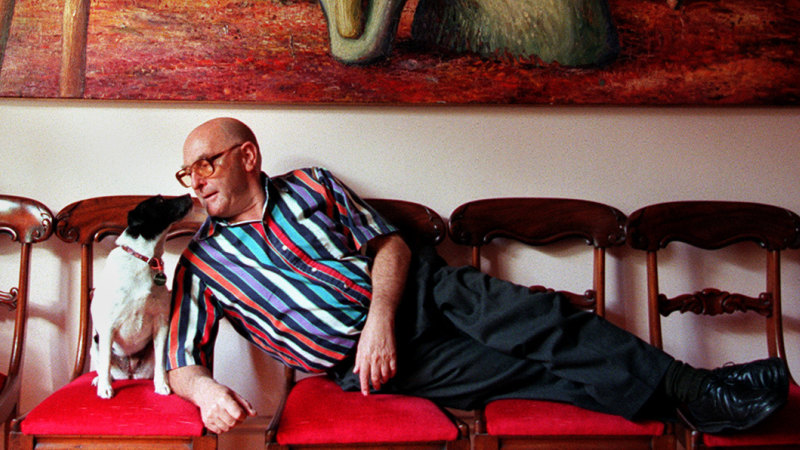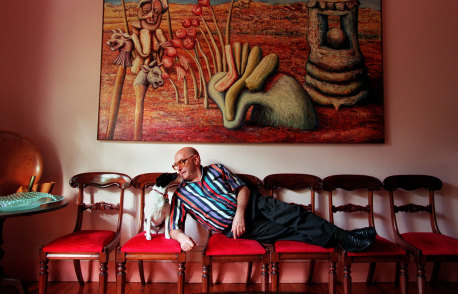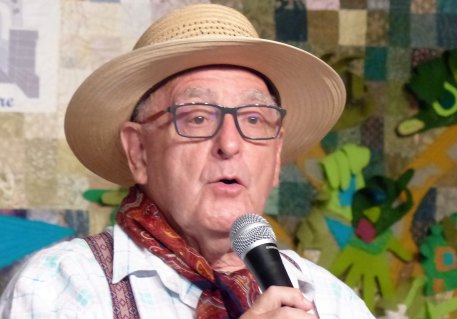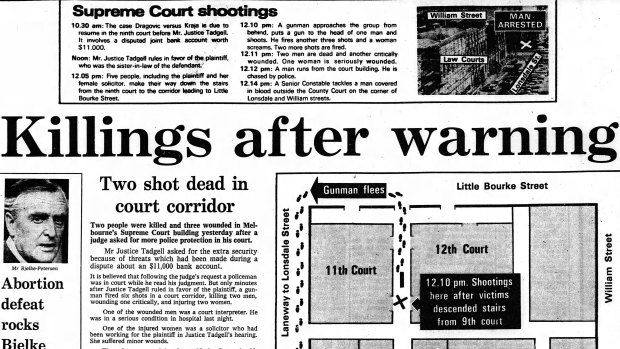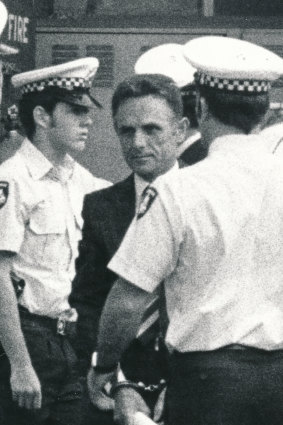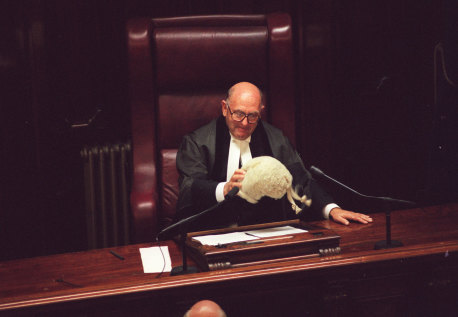When Howard Nathan was appointed to Victoria’s Supreme Court bench, he was immediately blacklisted by some brother judges for committing three unforgivable sins: “I was Jewish, gay and left-wing.”
He still doesn’t know which upset them the most.
The reclining judge in 1999 with dog Madge and one of the many artworks in his personal collection.Credit:Viki Lascaris
One refused to speak to him under any circumstances while others cut him dead, professionally and socially.
It was a time when judges were male and usually crusty, privileged and ferocious supporters of many legal traditions that even then belonged to another world.
And they all presented as enthusiastically heterosexual. The fact that Nathan was comfortable with his sexuality drove them nuts.
“They were not all bad, but the majority were miserably minded, misogynistic and simply unpleasant socially. They were the ones who were unbalanced,” he says.
“When I arrived, it was: ‘How are we going to deal with this?’ Some were puerile and quite infantile.”
It was only when a lawyer threatened to name judges living double lives that Nathan discovered why some of his colleagues were so openly homophobic.
“When this threat was made, I went to one of the senior judges and said we have something to deal with, and there was this ashen-faced senior judge almost perched on the window sill ready to jump. I had no idea then that he was a closet gay man.
“I went to another judge who said he was in the same position.”
Now 86 years old, Nathan is the perfect example of someone who wrings the most out of life. Truck driver, teacher, barrister, senior counsel who narrowly avoided being shot in court, government adviser, South Melbourne mayor, Supreme Court judge in Victoria and the West Indies, reformist, art patron, professor, sheep farmer and the baker of what he says are “dentally challenging” muesli cookies.
Man of many talents: Howard Nathan presiding over a local trivia night.
He lives happily in a beautiful cottage on the outskirts of Bendigo with his long-time partner.
The generous art patron’s sheep farm has a three-metre statue of a naked Ned Kelly and his home is filled with works.
Having worked the farm for years, Nathan says he would be happy never to see a sheep again. “I have had my hand where no Jewish boys should go.”
The miracle is not that Nathan has made a mark on so many canvases but that he made a mark at all.
His family eventually settled in a Gippsland dairy farm town where his father, Bob, was the local GP. In World War I, Bob drove a mule train that took ammunition to the front line and then collected the bodies.
In World War II, by then a doctor, Bob volunteered a second time. At the age of four Howard Nathan was sent to an Anglican boarding school in St Kilda: “It was really a child farm.”
His mother was an infrequent visitor and when his father returned from the war, Nathan was thrust into a world of violence and hate.
“He bought a medical practice in a declining country town. He was cruel — he was vicious — he was self-absorbed and a drunk.
“He broke a broom handle over my backside once and took to me with a knife. That ultimately led me to leave home.”
Nathan now knows the wars turned his father into a tyrant: “I didn’t know how damaged he was until around the time of his death.”
Instead of descending into self-pity, Nathan became driven, winning scholarships to private schools and universities, “seeking the praise from a father when it was never going to be forthcoming”.
He loved his time as a teacher at Collingwood Tech, remembering when a student fired a shot in another class from a gun made in the metal shop.
There is a case from 1980 that haunts him. His client, Nazire Dragovic, was the victim of a domineering brother-in-law, Sulejman Kraja, who beat her with the rubber hoses from a washing machine and controlled her money.
Nathan won the case, requiring Kraja to return $13,500 and pay $2000 in restitution for the assault. “We won the case hands down. During the trial he had threatened the interpreter and I raised it with the judge.”
May 22, 1980: The Age’s coverage of the Supreme Court shootings.Credit:Age archives
After the trial, Kraja’s barrister, Peter Vickery, said: “Howard, I’ve got to tell you my client threatened to shoot you and shoot you all.”
Nathan says: “Smartarse me, instead of taking it seriously I said: ‘They all say that’.”
Kraja, armed with a pistol, was waiting. He shot dead American singer and guitarist Jon Myeda, who was acting as a bodyguard, witness Mehemet Zeneli and interpreter Luke Cuni, 66. He wounded Dragovic and instructing solicitor Mary Anne Serafini.
Sulejman Kraja is escorted into the Coroners Court for the inquest into the Supreme Court shootings.Credit:Age archives
“We came down the stairs — a hapless witness, a bodyguard, my instructing solicitor and my client.
“Kraja came out of a side corridor and I heard the shots. He came up behind the interpreter and blew the top of his head off, he then moved to the bodyguard, put him in a headlock and blew off the side of his head.
“He moved to the witness, an old man who was supporting my client — he looked up and blew his entire head off from his mouth upwards. He then shot my client, shot her jaw off and she staggered away, and my instructing solicitor, a woman of immense courage, poise and sense. She fell down and he shot at her, grazing her arm and exploding on the wall next to her eye. Three dead, two wounded and he then came looking for me with one shot left in the pistol.
“A policeman, not knowing what had happened — another brave copper that went unrecognised — tackled him with a rugby tackle and brought him to the ground.
“I was pretty good at the time but 10, 20 and 30 years on, I am riven with guilt for not taking up the offer of Vickery.”
We talk of the law, of his interest in art, and being a fly-in fly-out judge in the West Indies, where he was known as Hurricane Howard.
He condemns the lawyers and judges who cling to the traditions and archaic customs of the courts at the expense of justice. He praises the new Bendigo Court for embracing a more equal system that doesn’t hide behind a coat of arms: “I’m not sure that lions and unicorns ever roamed around Victoria.”
He believes much of the modernisation is down to the work of Marilyn Warren, chief justice of the Supreme Court of Victoria from 2003 to 2017: “When she was appointed chief justice, she steered that ship through the shoals of discontent, improving the quality of work and the environment. She was marvellous.”
He speaks with sadness of a time when so many gay men felt the need to pretend to be something else. “They lived fake and phoney lives. From the minute they got out of bed, they lived a deceit for years. Often the wives were suspicious but non-confrontational.”
Justice Howard Nathan: Not big on the wig.Credit:The Age
(They include, he says, two prime ministers, some archbishops, senior police and a sprinkling of judges.)
Working on a government law committee, the police representative began to stutter when he saw Howard, realising they had met before in different circumstances. Nathan had to assure him private matters would remain exactly that. The officer later rose to the rank of assistant commissioner.
Then comes a bombshell: as a teenager, the judge was the victim of a crime. When Nathan was 13 or 14, he was walking through a bayside Elwood car park often used by learner drivers when a middle-aged paedophile opened the door of his black car and said: “Sonny, do you want to hop in to learn to drive?”
There were repeated encounters between the pair over nearly two years, with the offender taking the teenager to his home. “There were multiple toothbrushes in the bathroom, so I knew he was married.”
Then he disappeared. “I realise now I had become too old for him.”
Decades later and now a judge, Nathan was invited to address the Detective Training School. At the conclusion, an officer addressed the group, saying it was good to see so many female students and pointing to the portraits on the wall that were exclusively male.
“Well, I nearly fell off the platform because there he was [on the wall] — no doubt at all.”
That officer on the wall, we now know, was part of a conspiracy to protect a paedophile priest in Mildura.
When detective Denis Ryan was transferred to Mildura in 1971, the vice-principal of the local St Joseph’s College told him Monsignor John Day had molested a 12-year-old female student. He also told him Day was being protected by local detective Sergeant Jim Barritt.
Ryan launched his own inquiry and soon had more than a dozen statements from boys and girls that Day had assaulted them.
Because Ryan would not stop, he was forcibly transferred back to headquarters. His son suffered asthma so he could not return to Melbourne and resigned. Many years later, Ryan received an apology and compensation for the cover-up.
Nathan says the man in the black car had worked in Mildura, had risen to senior ranks and was involved in the transfer of Ryan: “Dinny Ryan was the victim of a connivance to thwart criminal justice on an almost unimaginable scale.
“They allowed a paedophile priest to maraud scores of families in that district for many years with catastrophic results.”
Most Viewed in National
From our partners
Source: Read Full Article
